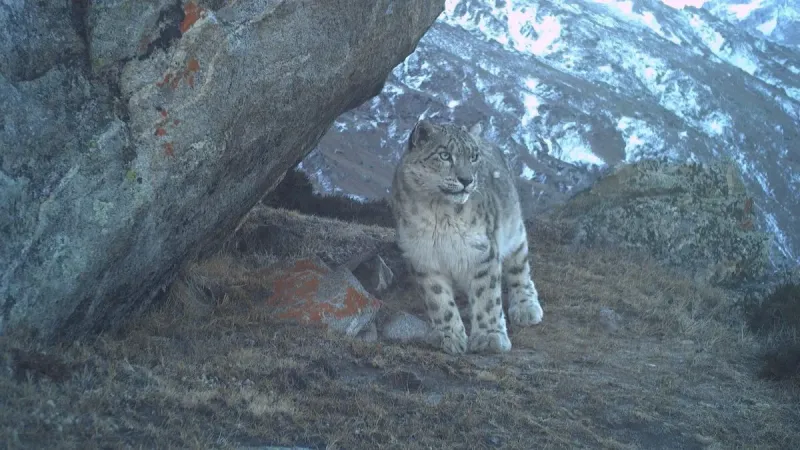
Snow leopard at Paddar, Kishtwar. Photo: Shahid Hameed and NCF.
A rigorous three-year camera trapping study has revealed remarkable news for India's high-altitude biodiversity: snow leopards are not only present year-round but are also actively breeding in the Union Territory of Jammu & Kashmir. This landmark research, a collaborative effort between the Nature Conservation Foundation (NCF) and the Wildlife Protection Department of Jammu & Kashmir, with crucial support from Royal Enfield Social Mission, marks a significant leap forward in conservation efforts.
The comprehensive study, conducted between 2022 and 2025 across the majestic Kishtwar Himalayas, was initiated under the nationwide Snow Leopard Population Assessment in India (SPAI) protocol. While earlier findings confirmed the species' presence, the 2024-25 phase brought exciting new insights, including the documentation of snow leopards during winter months in both Paddar (Jammu division) and Zojila (Kashmir division). This consistent presence underscores the landscape's vital role as a stable habitat supporting a resident population.
Over 3,000 camera trap nights across Kishtwar High Altitude National Park (KHANP), Paddar, and Zojila led to the identification of at least 12 adult snow leopards, with an estimated population of up to 20 individuals. Most notably, the presence of a mother with cubs in Kishtwar confirms the existence of a thriving breeding population.
“These findings reaffirm the importance of Jammu and Kashmir as a key snow leopard stronghold. It is time to treat the Kishtwar Himalayas not as isolated valleys, but as part of an interconnected conservation landscape,” stated Dr. Shahid Hameed, Wildlife Research and Project Coordinator at NCF. He added, “Much of the credit must go to the continued commitment of the Jammu and Kashmir Wildlife Department to conserve their high-altitude homes.”
Vigyat Singh, Director – Operations, Eicher Group Foundation, the CSR arm of Royal Enfield, emphasized the broader impact of the initiative:
"This study is a significant example of what can be achieved when scientific rigour, local stewardship, and institutional collaboration come together. Snow leopards are more than just an indicator species – conserving their habitat reflects the overall health and resilience of high-altitude ecosystems."
Beyond the elusive snow leopard, the study also documented 16 other mammal species, including the rare Himalayan brown bear, Himalayan wolf, common leopard, Kashmir musk deer, stone marten, pika, Asiatic ibex, and red fox. Interestingly, both snow leopards and common leopards were detected at the same camera locations in Paddar, prompting important questions about species interactions and the potential impact of climate change on range shifts.
The survey also incorporated a landscape-level threat assessment, based on interviews with over 300 households across Paddar, Warwan, Dacchan, and Marwah. Livestock depredation and crop damage emerged as primary livelihood challenges, highlighting the need for context-specific mitigation strategies and conflict resolution interventions.
As part of its community engagement efforts, the team conducted six outreach workshops in collaboration with the Wildlife Research & Conservation Foundation (WRCF). These sessions reached over 1,200 participants, including students and frontline forest staff, and focused on biodiversity awareness, field equipment demonstrations, mock drills for human-wildlife conflict, and hands-on conservation education.
This report underscores the critical need for landscape-level, adaptive conservation strategies, aligning with the vision of Project Snow Leopard and the Kunming-Montreal Global Biodiversity Framework, which strongly emphasizes the role of local communities in conservation.
The success of this study was made possible through extensive support from the Nature Conservation Foundation, Wildlife Protection Department, Jammu & Kashmir, and Royal Enfield Social Mission for surveys across the Kishtwar Himalayas in 2024-25. NCF expertly led field efforts, trained local youth, and the Department of Wildlife Protection, Jammu & Kashmir. All camera trap images are credited to the Department of Wildlife Protection, Jammu & Kashmir, and Nature Conservation Foundation.
Note: Based on a Press Release from Nature Conservation Foundation.





